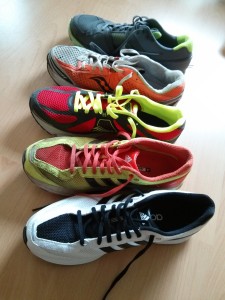On Saturday, I got myself new shoes – yippie! So, I thought I write a few lines about what to look out for on your shopping tour. When training for a marathon, it is important to have more than one pair for several reasons:
- Shoes support your feet. But your feet and legs should not get used to one kind of support as it might weaken bands and muscles.
- After long runs, dampers need some time to rebuild.
- Your shoes need time to dry from sweat – and rain.
- Some shoes have soft dampers which is good for your joints on long runs and hard grounds.
- Other shoes are more direct which helps getting power to the ground and being faster in competitions.
Below is my advice when buying new running gear:
- Especially when you are a beginner, look for a specialised shop.
- Find an assistant who is a runner herself. I mean a real marathoni – not some footballer or sports student.
- Ask the assistant to analyse your style of running: Some people are running on their forefoot, some have a twist in their heel to the left or right, etc. There are a lot of different shoes…
- Bring your old shoes. Good assistants know about the characteristics and can suggest a matching model. And one can read from the wearing of the sole what kind of support your style needs.
- Try as many shoes as possible but do it systematically: If you like a pair compare it to the next pair and decided which one is better. Only keep the ones you like. Do not collect tons of boxes 😉
- A specialised shop should have a treadmill, test shoes before buying.
- Your feet will get thicker while running. Therefore, get your shoes a size larger than usual – a good assistant knows this.
- If you are a regular and long-distance runner you should get a new pair every 12 to 18 months as the dampers wear out. I usually have an old (6-9 months) and a rather new pair.
- Buy new shoes well before the marathon / competition you are planing to wear them at. You have to get used to each other 😉
- Don’t decide based on look and colour. Neither helps at kilometre 33.
- Don’t buy online I you haven’t tested the shoes.
I am a “normal” runner with no twists and I am landing on my metatarsus rather than on my heel. As I am rather light, I prefer a direct feel versus a lot of damping. So, here is my setup in case anyone cares (from top to bottom):
- An old pair of rather soft Nikes which I use mostly in the rain. No clue what they are called but I remember buying them for the Hamburg marathon.
- I bought the Saucony Mirage 1 for the Paris marathon. I like them because they are light, well ventilated and have good damping for my taste.
- The new Saucony Mirage 3 have a very soft upper material which felt very comfortable in the shop and did not disappoint on the first miles.
- The Adidas Adizero Boston 4 is very light and has little damping. The upper holds the foot very well without feeling hard. The ventilation is very good. The perfect shoe for me; worked very well on the Rome marathon.
- There has been no product update yet, so my new Bostons are just like my old ones. Most likely these will be my shoes for running with Barry.

Brilliant Jan! Love the picture 😉 Barry will definitely be going to a specialist running shop for his gear. Great advice on the trainers. Thank you. What do you know about compression wear?
Thanks Abbey 🙂
I was planning to write more about gear this week. So, compression socks will be next then!